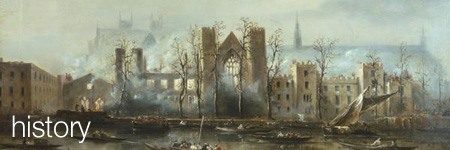
Drury Lane
Aldwych (WC2) Originally Via de Aldwych, indicating a small dependency of Saxon London, Drury Lane derives its name from the once important family of the Drurys, who had a house here. At one time a street of the first fashion and the promenade of nobles, its world-wide fame is really due to its succession of famous theatres. The first, called the Phoenix, was built before 1617. This is said to have formerly been a cockpit, which was apparently destroyed by the mob in the year mentioned and rebuilt. (Reference: Smith's Streets of London, p. 195)
The following brief history of the Drury Lane theatres is extracted from the "Souvenir" presented to the audience at the opening of the present reconstructed Theatre Royal, Drury Lane, and may be taken as authoritative "Opened, May 7, 1663, under Royal Letters Patent granted to Thomas Killigrew by Charles II. Rebuilt by Sir Christopher Wren and reopened March 26, 1674. Rebuilt from a design by Henry Holland and reopened March 12, 1794. Rebuilt by Benjamin Wyatt and reopened October 10, 1812. Partially rebuilt 1894, 1904, and 1908. Fourth theatre, with entirely new auditorium, reopened April 1922. "He would be a bold man who would attempt to write the complete story of Drury Lane-such a literary feat has always been regarded as impossible.
Few historians of the stage have been more intimately associated with Old Drury than Mr. Austin Brereton. From his entrancing epitome the following facts have been culled. "'The second Charles, returning to England after an exile of nearly nine years, was on the eve of landing at Dover. Fortunately for himself and for the readers of this veracious chronicle, the immortal diarist, Samuel Pepys, was a member of the jovial band. Walking upon the decks, all the afternoon, were "persons of honour, among others, Thomas Killigrew (a merry droll, but a gentleman of great esteem with the King) , who told us many merry stories." Thomas was a page of honour, when he was twenty-one, to Charles I. It is evident that he was one of the early friends of Charles II, for in 1647 he was with the Prince in Paris. He represented Charles in Venice in On returning to England with the King he was appointed Groom of the Bedchamber to His Majesty. Thus it came about that Killigrew was entrusted by Charles with the patent for Drury Lane. "'Killigrew's company performed from November 8, 1660, in a temporary building which had been transformed from a famous tennis-court which stood within the precincts of Clare Market. in Bear Yard, between Vere Street and Lincoln's Inn Fields. Killigrew, finding the premises too small for his purpose, entered into arrangements for the erection of a suitable playhouse. . The land secured was .in Vinegar Yard. Here was built the first Theatre Royal, Drury Lane, and on this site, with sundry additions, which now extend to Drury Lane, the four theatres which have added so much lustre to the English theatre have stood. Be it, then, set down that the first Theatre Royal, Drury Lane, was opened on May 7, 1663, and that the first play performed there was The Humorous Lieutenant, by Francis Beaumont and John Fletcher. . In January 1672 the first theatre was destroyed by fire. The new theatre, built by Sir Christopher Wren, at a cost of £4,000, was opened on March 26, 1674. In November 1682 the King's and the Duke of York's companies, the latter with Betterton at their head, were amalgamated.The chief members of Killigrew's original company retired about this time, so that the great actor of the age, Betterton, was left in undisputed sway of Drury Lane. . "
'Most notorious of all' (of the King's company) 'was Eleanor Gwyn, whose association with the theatre began when she sold oranges in the pit. From there she was promoted to the stage of the King's house. Born in 1650, she made her first appearance, fifteen years later, as Cydaria in The Indian Emperor. Her last original character was Almahide in Dryden's Conquest of Granada. She spoke the Prologue to this play in a straw hat as large as a cartwheel. Charles II was present and was convulsed with laughter.' "After the death of Charles II and of Killigrew, 'the vicissitudes of the players were varied and serious until in 1711 three actor-managers, Robert Wilks, Thomas Doggett, and Colley Cibber came into control. It was Doggett who founded, in 1716, .the annual prize for a rowing competition for Thames watermen "-Doggett's Coat and Badge. "The most famous member of the triumvirate was Cibber. The middle of the eighteenth century witnessed the coming as manager at Drury Lane of David Garrick and the beginning of nearly thirty years of prosperity for the old house. From Garrick we pass to .Richard Brinsley Sheridan. His management began in 1777 and lasted until 1809. John Henderson, Mrs. Siddons, John Philip Kemble, and Dora Jordan were among the celebrated actors who appeared in the second Drury Lane under Sheridan. The third theatre was opened March 12, 1794. Kemble as Macbeth, Mrs. Siddons as Lady Macbeth, and Charles Kemble formed a fine constellation for the opening of this gorgeous establishment.
It was destroyed by fire on February 24, 1809. "In the story of the fourth theatre the most momentous event during its early period was the first appearance in London of Edmund Kean as Shylock. William Charles Macready acted here for the first time as Virginius. Two farewells, which are landmarks in the story of the English stage, were those of Macready and Henry Irving.' (From the Souvenir, see supra) Drury Lane was one of the first places in London visited by the Great Plague of 1665. (Reference: Jesse's London, vol. I, p. 362) Here Nell Gwynne resided. Pepys says: "Saw pretty Nelly standing at her lodging door in Drury Lane in her smock sleeves and bodice. A mighty pretty creature."